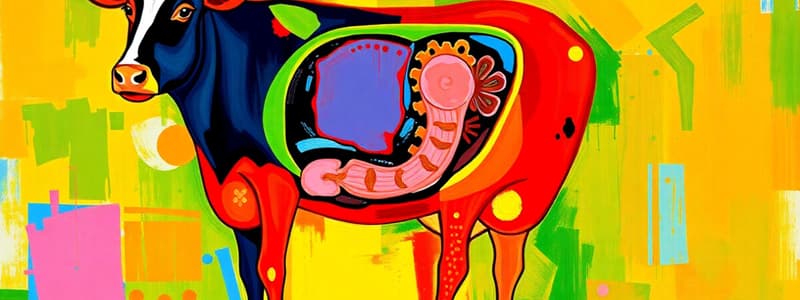Podcast
Questions and Answers
What is the primary purpose for which cows are raised?
What is the primary purpose for which cows are raised?
- Horses for riding
- Labor animals for agriculture
- Milk and meat production (correct)
- Companionship
What is unique about a cow's digestive system?
What is unique about a cow's digestive system?
- It has a four-chambered stomach. (correct)
- It has a single-chambered stomach.
- It relies solely on fermentation in the intestines.
- It is incapable of digesting cellulose.
What term describes the process when cows regurgitate and chew their food?
What term describes the process when cows regurgitate and chew their food?
- Digestion
- Mastication
- Ingestion
- Ruminating (correct)
What is the gestation period for cows?
What is the gestation period for cows?
Which of the following best describes cow communication?
Which of the following best describes cow communication?
Why is regular milking important for cows?
Why is regular milking important for cows?
How are calves typically weaned from their mothers?
How are calves typically weaned from their mothers?
What physical characteristic is typical of cows?
What physical characteristic is typical of cows?
Flashcards
Artiodactyla
Artiodactyla
Cows belong to this order, which encompasses even-toed ungulates, characterized by having hooves with an even number of toes.
Herd
Herd
A group of cows together.
Rumination
Rumination
The process of cows bringing up partially digested food back to the mouth for further chewing and breaking down. It's a crucial step in their unique digestive system.
Rumen
Rumen
Signup and view all the flashcards
Estrus
Estrus
Signup and view all the flashcards
Four-Chambered Stomach
Four-Chambered Stomach
Signup and view all the flashcards
Milk Production
Milk Production
Signup and view all the flashcards
Gestation
Gestation
Signup and view all the flashcards
Study Notes
Physical Characteristics
- Cows are mammals, belonging to the order Artiodactyla (even-toed ungulates).
- They are domesticated herbivores, typically raised for milk and meat production.
- Adult female cows are called cows; adult males are called bulls. Young are called calves.
- Body size varies depending on breed, but generally large.
- Distinctive features include a large, muscular body; four legs; a long, tapering tail; and large, somewhat flat, ears. Hooves are designed for varied terrain.
- Coat color varies greatly amongst breeds, exhibiting black, brown, white, red, and various combinations.
Digestive System
- Cows have a four-chambered stomach, adapted for digesting plant material.
- The rumen is the largest compartment; it hosts microorganisms capable of breaking down cellulose (plant fiber).
- This process is crucial for extracting energy from the tough cellulose in grasses and other plant foods.
- Further compartments like the reticulum, omasum, and abomasum finish the breakdown process.
- Ruminants, like cows, regularly regurgitate and chew their partially digested food. This process is known as rumination.
Breeding and Reproduction
- Cows are seasonally polyestrous, meaning they experience multiple estrous cycles within a specific time frame each year.
- The estrous cycle is the period from one heat (estrus) to the next.
- Estrus is the period when a female is receptive to mating.
- Gestation (pregnancy) period is approximately nine months.
- A cow usually gives birth to one calf at a time but twins are possible.
- Calves are typically weaned from their mother within a few months.
Milk Production
- Cows, by design and through domestication, are a critical resource for milk production.
- Milk production varies considerably based on breed, nutrition, and management practices.
- Milk is a complex liquid containing proteins, fats, carbohydrates, vitamins, and minerals.
- Regular milking process helps the cow maintain its mammary system function.
Behavior
- Cows are social animals.
- Groups of cows are often observed together as herds.
- Communication among cows happens through a range of visual cues, vocalizations, and body language like postures.
- Herd dynamics are complex and influence behaviors in the herd structure and social hierarchies.
- Cows are largely herbivores and exhibit behaviors focused on foraging for adequate nutrition.
- Cows typically exhibit a placid temperament, though they can be protective of calves and their herd.
Importance to Humans
- Cows play a substantial role in human agriculture and industry.
- Milk from cows is a major source of nutrition worldwide.
- Beef from cows is a dietary staple protein source for many.
- Cow manure can be used as a natural fertilizer in agricultural settings.
- Cows play a significant economic role in many farming communities.
Studying That Suits You
Use AI to generate personalized quizzes and flashcards to suit your learning preferences.




